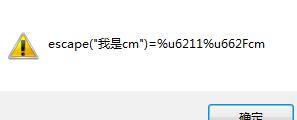我们主要通过两种形式提交向服务器发送请求:URL、表单。而表单形式一般都不会出现乱码问题,乱码问题主要是在URL上面。通过前面几篇博客的介绍我们知道URL向服务器发送请求编码过程实在是实在太混乱了。不同的操作系统、不同的浏览器、不同的网页字符集,将导致完全不同的编码结果。如果程序员要把每一种结果都考虑进去,是不是太恐怖了?有没有办法,能够保证客户端只用一种编码方法向服务器发出请求?
有!这里我主要提供以下几种方法
一、javascript
使用javascript编码不给浏览器插手的机会,编码之后再向服务器发送请求,然后在服务器中解码。在掌握该方法的时候,我们需要料及javascript编码的三个方法:escape()、encodeURI()、encodeURIComponent()。
escape
采用SIO Latin字符集对指定的字符串进行编码。所有非ASCII字符都会被编码为%xx格式的字符串,其中xx表示该字符在字符集中所对应的16进制数字。例如,格式对应的编码为%20。它对应的解码方法为unescape()。

事实上escape()不能直接用于URL编码,它的真正作用是返回一个字符的Unicode编码值。比如上面“我是cm”的结果为%u6211%u662Fcm,其中“我”对应的编码为6211,“是”的编码为662F,“cm”编码为cm。
注意,escape()不对”+”编码。但是我们知道,网页在提交表单的时候,如果有空格,则会被转化为+字符。服务器处理数据的时候,会把+号处理成空格。所以,使用的时候要小心。
encodeURI
对整个URL进行编码,它采用的是UTF-8格式输出编码后的字符串。不过encodeURI除了ASCII编码外对于一些特殊的字符也不会进行编码如:! @ # $& * ( ) = : / ; ? + ‘。

encodeURIComponent()
把URI字符串采用UTF-8编码格式转化成escape格式的字符串。相对于encodeURI,encodeURIComponent会更加强大,它会对那些在encodeURI()中不被编码的符号(; / ? : @ & = + $ , #)统统会被编码。但是encodeURIComponent只会对URL的组成部分进行个别编码,而不用于对整个URL进行编码。对应解码函数方法decodeURIComponent。
当然我们一般都是使用encodeURI方来进行编码操作。所谓的javascript两次编码后台两次解码就是使用该方法。javascript解决该问题有一次转码、两次转码两种解决方法。
一次转码
javascript转码:
?
|
1 2 |
|
转码后的URL:http://127.0.0.1:8080/perbank/ShowMoblieQRCode.servlet?name=%E6%88%91%E6%98%AFcm
后台处理:
?
|
1 2 3 4 |
|
输出结果:
前台传入参数:??????cm
经过解码后参数:我是cm
二次转码
javascript
?
|
1 2 |
|
转码后的url:http://127.0.0.1:8080/perbank/ShowMoblieQRCode.servlet?name=%25E6%2588%2591%25E6%2598%25AFcm
后台处理:
?
|
1 2 3 4 |
|
输出结果:
前台传入参数:E68891E698AFcm
经过解码后参数:我是cm
filter
使用过滤器,过滤器LZ提供两种,第一种设置编码,第二种直接在过滤器中进行解码操作。
过滤器1
该过滤器是直接设置request的编码格式的。
?
|
1 2 3 4 5 6 7 8 9 10 11 12 13 14 15 16 17 18 19 20 |
|
配置:
?
|
1 2 3 4 5 6 7 8 9 10 11 12 13 |
|
过滤器2
该过滤器在处理方法中将参数直接进行解码操作,然后将解码后的参数重新设置到request的attribute中。
?
|
1 2 3 4 5 6 7 8 9 10 11 12 13 14 15 16 17 18 19 20 21 22 23 24 25 26 27 28 29 30 31 32 33 34 35 36 37 38 39 40 41 42 43 44 45 46 47 48 49 50 51 52 53 54 55 56 57 58 59 60 61 62 63 64 65 66 67 68 69 70 71 72 73 74 75 76 77 |
|
配置:
?
|
1 2 3 4 5 6 7 8 |
|
其他
1、设置pageEncoding、contentType
<%@ page language="java" contentType="text/html;
charset=UTF-8" pageEncoding="UTF-8"%>
2、设置tomcat的URIEncoding
在默认情况下,tomcat服务器使用的是ISO-8859-1编码格式来编码的,URIEncoding参数对get请求的URL进行编码,所以我们只需要在tomcat的server.xml文件的标签中加上URIEncoding=”utf-8″即可。
以上就是本文的全部内容,希望对大家学习java中文乱码问题有帮助
本文链接:https://my.lmcjl.com/post/13821.html

4 评论